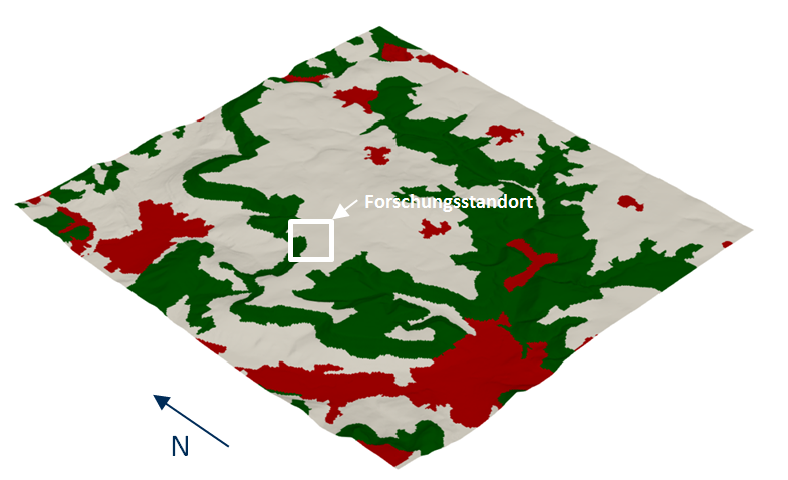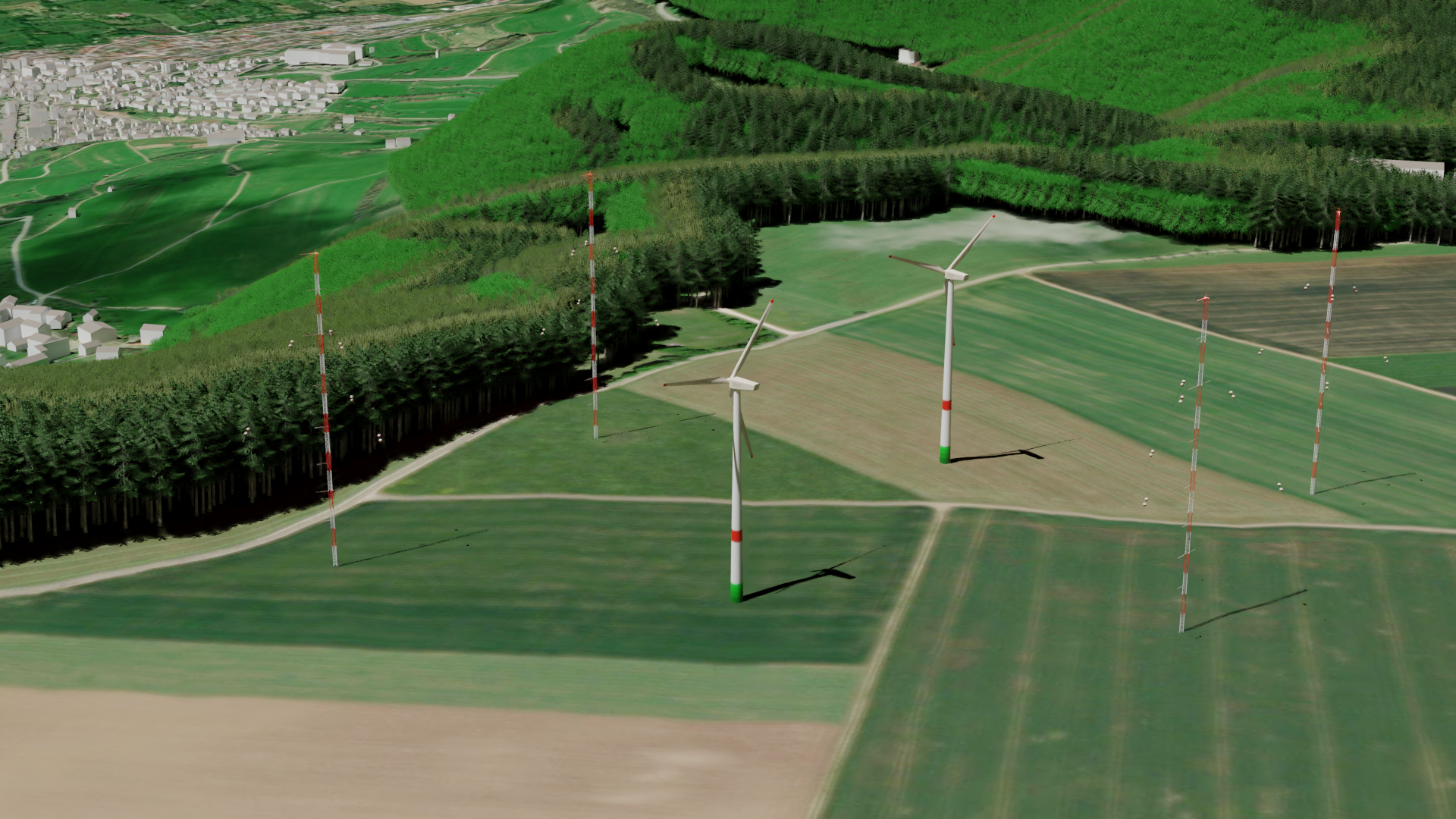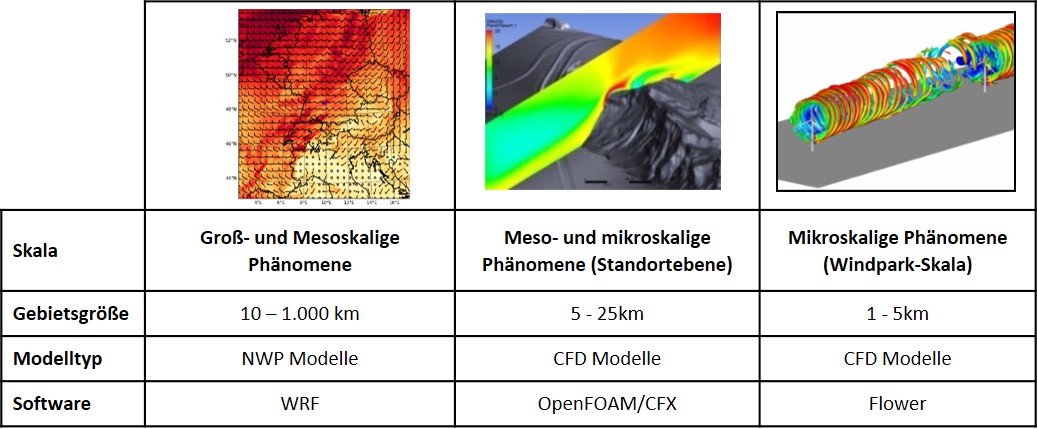project WINSENT Site search for wind turbines
WINSENT (Wind Science and Engineering in Complex Terrain) is a collaborative project involving the University of Tübingen, Karlsruhe Institute of Technology (KIT), the TUM in Munich, the Center for Solar Energy and Hydrogen Research Baden-Württemberg, and Esslingen University of Applied Sciences. It is funded by the German Federal Ministry for Economic Affairs and Energy under the project number 0324129A-F, and the Baden-Württemberg Ministry of the Environment, Climate Protection and the Energy Sector. The project aims to realise and characterise a Southern German research platform for wind power in the hilly and complex terrain. The test site is located near Donzdorf in the immediate vicinity of the Albtrauf (Alp escarpment, Figure 1). The environs are characterised by very different land use, such as built-up areas, forest and agricultural use (Figure 3).
Two research wind turbines with a hub height of 75 m, a rotor diameter of 50 m and a power of 750 kW will be installed as part of the project. In addition to setting up the test field, a method for the high-resolution, three-dimensional spatial and temporal simulation of the wind conditions at wind turbine sites in the complex terrain will be developed. A continuous, coupled chain of models with high temporal and spatial resolution is to be created for this purpose, which will allow the accurate characterisation of the flow fields on the test site in conjunction with detailed measurements. Figure 4 shows an overview of the elements in the model chain.
Esslingen University of Applied Sciences is pursuing the research objectives detailed below:
- Physical modelling of meso-scale and micro-scale climate phenomena with particular focus on:
- Mapping the surface unevenness
- Turbulence modelling
- Modelling the radiative heat exchange
- Taking humidity into account in the model
- Modelling the waves formed when the flow is deflected by obstacles in the complex terrain
- Verification and validation of the models
- Linking the models to describe the meso-scale and micro-scale climatic phenomena on the site level with the weather models which describe large-scale and meso-scale climatic phenomena, and the micro-scale models which describe the incident flow for the research wind turbine to form a coupled model system
- Micro-climatic characterisation of the wind energy research site.
Some of the calculation results are shown in Figures 5 & 6.
FUNDING
WINSENT is funded by the German Federal Ministry for Economic Affairs and Energy, and the Baden-Württemberg Ministry of the Environment, Climate Protection and the Energy Sector.
- Project number: 0324129A-F
- Project duration: December 2016 - May 2020
Pragmatic Wind Modelling research project
The expansion of wind energy as a renewable, climate-friendly source of energy is proceeding apace around the globe. Increasing use is being made of hilly and mountainous, as well as tree-covered areas in which erratic wind flows and turbulence occur due to the site structure and the land use. The search for suitable sites for wind turbines in these regions requires the development of innovative simulation methods for the detailed description of these meso-scale and micro-scale flow phenomena in the atmospheric boundary layer and to forecast the yields. Many models are available for this purpose; some are available as services, others are intended as research tools. They can resolve different physical processes and run with various spatial and temporal resolutions. Every decision taken about the design and resolution of the model has an impact on the costs incurred to operate this model – and the accuracy of the output.
So, which models are best? How can the benefit-cost ratio of a number of models be assessed? And which factors influence the results?
These questions form the core aspect of the research in two coordinated German and Swiss research projects. The project partners will carry out simulations with several different models and assess the accuracy with the aid of data from the wind test site (Figure 1) and several other sites in Germany and Switzerland.
Results are expected in 2019 and 2020.
IT Infrastructure
The simulation of wind turbine sites places enormous demands on the capability of the IT infrastructure. High-performance computers are used which produce acceptable response times for practical applications when aided by distributed computing on a large number of CPUs. A very good basis is provided by Esslingen University being integrated into the bwHPC computing infrastructure and the university’s in-house computer cluster.
More information can be found on the Esslingen University of Applied Sciences webpage on High Performance Computing
publications
- Knaus, H.; A. Rautenberg; J. Bange: Model comparison of two different nonhydrostatic formulations for the NavierStokes equations simulating wind flow in complex terrain. Journal of Wind Engineering & Industrial Aerodynamics 2017, 169, pp. 290-3.
- Knaus, H.; Hofsäß, M.; Rautenberg, A.; Bange, J. Application of Different Turbulence Models Simulating Wind Flow in Complex Terrain: A Case Study for the WindForS Test Site. Computation 2018, 6, 43.
- El Bahlouli, A.; Rautenberg, A.; Schön, M.; zum Berge, K.; Bange, J.; Knaus, H. Comparison of CFD Simulation to UAS Measurements for Wind Flows in Complex Terrain: Application to the WINSENT Test Site. Energies 2019, 12, 1992.
- Leukauf D., El-Bahlouli A., zum Berge K., Schön M., Knaus H., and Bange J., 2019: The impact of a forest parametrization on coupled WRF-CFD simulations during the passage of a cold front over the WINSENT test-site. Wind Energy Science Discussions, 1–24. https://doi.org/10.5194/wes-2019-68
- El Bahlouli, A.; Leukauf, D.; Platis, A.; Berge, K. Z.; Bange, J.; Knaus, H.: Validating CFD predictions of flow over an escarpment using ground-based and airborne measurement devices. Energies 2020, 13, 4688; doi:10.3390/en13184688
- Letzgus, P; El Bahlouli, A; Leukauf, D.; Hofsäß, M.; Lutz, T.; Krämer, E: Microscale CFD Simulations of a Wind Energy Test Site in the Swabian Alps with Mesoscale Based Inflow Data. J. Phys.: Conf. Ser. 1618 (2020), doi:10.1088/1742-6596/1618/6/062021
- S. Barber, A. Schubiger, S. Koller, A. Rumpf, H. Knaus and H. Nordborg: Actual Total Cost reduction of commercial CFD modelling tools for Wind Resource Assessment in complex terrain. J. Phys.: Conf. Ser. 1618 (2020)
zum Berge, K., Schoen, M., Mauz, M. Platis, A., van Kesteren, B., ·Leukauf, D., · El Bahlouli, A. · Letzgus, P., Knaus, H, Bange,J.: A Two-Day Case Study: Comparison of Turbulence Data from an Unmanned Aircraft System with a Model Chain for Complex Terrain. Boundary-Layer Meteorol (2021). https://doi.org/10.1007/s10546-021-00608-2
Barber, S.; Schubiger, A.; Koller, S.; Eggli, D.; Radi, A.; Rumpf, A.; Knaus, H. A New Decision Process for Choosing the Wind Resource Assessment Workflow with the Best Compromise between Accuracy and costs for a Given Project in Complex Terrain. Energies 2022, 15, 1110. https://doi.org/10.3390/en15031110
S. Barber, A. Schubiger, S. Koller, D. Eggli, A. Radi, A. Rumpf, H. Knaus: The wide range of factors contributing to wind resource assessment accuracy in complex terrain. Wind Energ. Sci., 7, 1503–1525, 2022, https://doi.org/10.5194/wes-7-1503-202.
zum Berge, K., Gaiser, A., Platis, A., Knaus, H. and Bange, J. (2022) Seasonal Changes in Boundary-Layer Flow over a Forested Escarpment Measured by an Uncrewed Aircraft System, Boundary Layer Meteorology, https://doi.org/10.1007/s10546-022-00743-4
Hasan Mashni, Hermann Knaus, Andreas Platis and Jens Bange: Development of an airfoil-based passive volumetric air sampling and flow control system for fixed-wing UAS. Bulletin of Atmospheric Science and Technology 2023, https://doi.org/10.1007/s42865-023-00057-4
Frank Ulrich Rückert, Burhan Ibrar, Arslan Ahmed, Benjamin Allweyer, Dirk Hübner, Friedrich Klinger, Hermann Knaus, Ali Cemal Benim: Fluid flow and heat transfer of a novel passive cooling system for gearless wind turbines with a power range of 3–12 MW (2024), https://doi.org/10.1016/j.energy.2024.133478
Interested? Find out more! about our degree programmes
Explore now and
find a course












